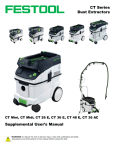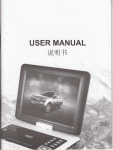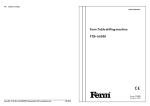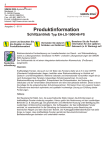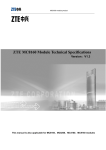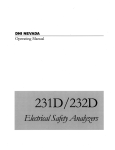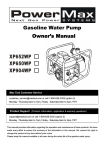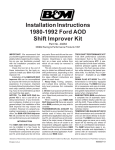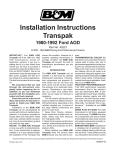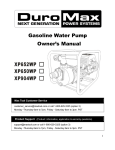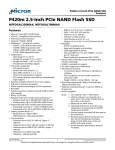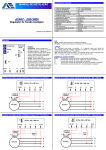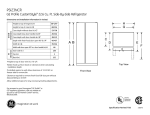Download ALL YOU NEED TO KNOW
Transcript
ALL YOU NEED TO KNOW CONTENTS 1 STORAGE 2 MAINTENANCE OF STOCK 3 COMMISSIONING 4 ELECTROLYTE LEVELS (ACID LEVELS) IN SERVICE 5 SELECTING THE CORRECT BATTERY FOR THE APPLICATION 6 REMOVING BATTERIES & INSTALLING BATTERIES ON VEHICLES B BEFOREIHANDLING, CHARGING OR INSTALLING U BATTERIES, PLEASE UNDERSTAND AND COMPLY WITH THE PRECAUTIONS GIVEN T IN HEALTH & SAFETY INFORMATION' IN THIS ' CATALOGUE. 7 CHARGING OFF-VEHICLE 8 CHECKING BATTERY PERFORMANCE 9 MAINTENANCE IN SERVICE 1. STORAGE a1. STORAGE Practice first in, first out. B a) Always rotate your stock. Practice first in, first out. r Batteries slowly lose their charge, and good stockB m b rotation stops batteries going flat in storage, and battery. c makes sure that the customer buys a good (Heat causes b) Store batteries in a cool, dry well ventilated area. b c) Protect batteries from excessive heat. (Heat causes e batteries to lose their charge more quickly, and d b e fexcessive heat can damage batteries). d) Store batteries in an upright position to prevent them e falling over or leaking. a e) Do t not stack batteries on top of other batteries to f avoid scratching, tearing labels and damaging that stand proud of the lid. tterminals S f) Store batteries on racks or on pallets - not on the floor. d g Small stones or sharp points on a concrete floor can damage the base of the battery and cause leakage. d U g) Make sure handles are left flat (in the down position). g Upright handles are more likely to be damaged. 2. MAINTENANCE OFOF STOCK 2. MAINTENANCE STOCK W a WET s BATTERIES a) Check the open-circuit of the batteries m If you havevoltage a voltage below 12.50Vin your stock every month using a digital voltmeter or a ( (multimeter. If you have a voltage below 12.50V ((6.25V for 6V batteries), give them a refreshing charge. (See Section 7). b) Scrap any batteries that drop below 11.00V - these batteries will have developed a sulphation that cannot be completely reversed by charging, and so will not give the expected performance and life to the customer. DRY D r CHARGED BATTERIES a) a If you keep the batteries cool and dry and do not rremove the seal, dry charged batteries do not need any other attention. a b) b The maximum storage time of dry charged batteries before they are commissioned by filling with acid is b 24 months. 2 3. COMMISSIONING 3. COMMISSIONING WET BATTERIES W a) a Do not supply a battery to a customer (end user) if the voltage is below 12.50V (6.25V for 6V batteries). v Charge any batteries with voltages below these values. C b) b We recommend you check the condition of the battery before selling it. b DRY CHARGED BATTERIES D a) a Only commission a dry charged battery when it is needed for a customer. n b) If fitted, remove and discard any sealing plugs, tape or foil. c) If fitted remove and keep normal vent plugs and terminal covers (usually red and black). c) If fitted remove keepgrade normal ventsulphuric plugs and d) For filling, use aand battery dilute acid of terminal covers (usually red and black). specific gravity 1.270 - 1.280 at 25°C conforming to d) For filling, a battery grade dilute sulphuric BS3031 oruse better (N.B. contaminated acid withacid of specific gravity 1.270 - 1.280 at 25° conforming to impurities can seriously damage theClife of the battery, BS3031 or better (N.B. contaminated acid with in some cases reducing this to a few days. Do not use impurities canbatteries). seriously damage the life of the battery, acid from old in some cases reducing this and to a the few battery days. Do not use e) The temperature of the acid should acid from old batteries). both be at room temperature in the range of 15 - 30°C. e) Fill Theeach temperature acid theof battery should f) cell with of thethe acid to and a level 8 - 15mm above both be at temperature in the of 15 - 30° C. the tops of room the plates. Fill each cell range one after the other f) Fill each cell with the acid to a level of 8 15mm above and complete the filling in one operation. the tops ofbattery the plates. each cell one g) Leave the for 20Fill - 30 minutes andafter thenthe other and complete the filling involtage. one operation. measure the open-circuit If it is below 12.50V, g) Leave minutes andadjust then the chargethe thebattery battery.forIf20 it is- 30 above 12.50V, measure the open-circuit voltage. If is below 12.50V, it acid levels to the correct operating levels with dilute charge the battery. If it is above 12.50V, adjust sulphuric acid of specific gravity 1.270 - 1.280. the levels to the correct levels with dilute h) acid Fit the normal vent plugs operating and terminal covers. sulphuric acid of specific gravity 1.270 1.280. i) Wash the battery with hot water and dry it. h Performance checks on newly commissioned j) dry charged batteries using modern electronic digital testers using conductance technology are not d recommended (examples are - testers supplied by testers using not Midtronics orconductance Bosch). Thetechnology results canare be misleading recommended are - testers supplied by until the battery(examples has undergone some service use. Midtronics or Bosch). The results can be misleading until the battery has undergone some service use. 4. ELECTROLYTE LEVELS (ACID) LEVELS IN SERVICE P PLEASE READ BEFORE ADJUSTING ACID LEVELS However, ii) Do not top up to the maximum levels a battery that needs charging as levels rise on charging. However, if the levels are below the tops of the separators, top up with distilled or de-ionised water until the separators are just covered. ii) Adjust levels to the maximum levels only after the battery has stood for at least an hour after charging. i Never overfill a battery as the acid may come out of iii) the vent plugs when the battery is being charged. iv) Use only distilled or de-ionised water for topping up. S Sulphuric acid should never be used except for the initial filling of a battery. a) When the battery is in service, the electrolyte levels should be checked and adjusted to the levels given below. b) If the battery has a maximum level line on the side of the container fill to this level. cc) If there is no maximum line but there are filling tubes projecting from the bottom of the lid, fill to the bottom of the tubes. ALL YOU NEED TO KNOW d) If there is no maximum line nor filling tubes in polypropylene batteries, fill to 7mm (0.25 inches) below the bottom edge of the lid skirt. d e) If there is no filling tubes in hard rubber batteries, fill to p 15mm (0.5 inches) above the tops of the separators. b e To prevent the connector shorting e) Disconnect the live connector second. If a CMS is against the car, place an insulator such as a rubber used, the connector will still remain live after it has been glove over the connector. disconnected. To prevent the connector shorting f) Remove the hold-down clamps. against the car, place an insulator such as a rubber glove over the connector. P f) Remove the hold-down clamps. 5. SELECTING THE CORRECT BATTERY FOR THE APPLICATION CAR & COMMERCIAL VEHICLE (CV) BATTERIES a) Select the specified battery from the Application C Section of this catalogue. a b) On S 24 Volt systems, or when 2 x 12 Volt batteries are to do this will result in greatly fitted in parallel,Failure both batteries should be replaced at b rthe same time. Failure to do this will result in greatly f freduced battery life for the new battery that has been t Failure to do this will result in greatly Failure to do this will result in greatly fitted. r r When f batteries are joined in series, the negative fterminal of one battery is connected to the positive W terminal of the other, giving a total voltage of 24 Volts. t Thet Ampere-hour capacity of the system is the same as that T of the individual batteries. When a batteries are joined in parallel, the positive terminals of the two batteries are connected together, W The voltage systemare remains andt the negative terminals of the of twothe batteries also uconnected together. The voltage of the system remains a unchanged at 12 Volts but thevoltage Ampere-hour capacity of c The of the system remains voltage of the system remains the usystem is double The that of the individual batteries. u LEISURE BATTERIES t a) Use L the battery with the performance and size recommended by the equipment supplier. a b) Wer recommend that a leisure battery in a cycling application, should be sized so that it is not normally b The discharged to more than 50 percent state of charge. a lThis will ensure that the battery gives a good life. The d life Tof a battery regularly discharged by 50 percent is The The about l 5 times that of a battery regularly discharged to l If this represents 50 percent state 100 percent i.e. a load of 3A for 10 hours will discharge a oa battery by 30AH. If this represents 50 percent state 1 of charge, webywould recommend a 60 AH50battery. a battery 30AH. If this represents percent state If this represents 50 percent state o o c) d) e) f) g) P a) b c) d) a) I a) a) 6. REMOVING AND INSTALLING R BATTERIES ON VEHICLES R w R REMOVING BATTERIES w a a) It is good practice to tell the customer that while you w will do your bestSwitch to keepoff the settings, it is allmemory electrical loads and p be lost. rpossible these might N.B. On some Switch off all electrical loads and b b) cMake sure the hand-brake is on, and that the car is in r n N.B.loads On some Switch off all electrical and neutral or park. Switch off all electrical loads and c r N.B. On some remove the ignition keys from the car. N.B. On some c cars, the doors will lock when the battery is disconnected s so this is why the key should be removedInstall from a the car. A Also, switch off any non-factory fitted alarms. C Install a c not, turn dc) Check C t that the cigar lighter is still working - ifInstall a ignition key to the auxiliary position. Install a in This can result d the C Computer Memory Saver (CMS). This can result in d d) Disconnect the earth connector first - this is normally t This can result in the negative on modern vehicles. This can result in the loss of memory settings (please refer to the vehicle h handbook). c d) e) e) e) f) g) g) g) h) i) PREPARATION OF A BATTERY FOR FITTING a) Check that the battery has the correct polarity for the vehicle. b) Check that the battery has the correct height for the b vehicle - if a battery is too high it can short out on the bonnet. bonnet or the bottom of the seat, or it can damage the It isbonnet. good practice to place the old and new battery side side to compare polarities, hold-downs and c) It by is good practice to place the old and new battery Some batteries have hold-downs at both sides and performance levels. side by side to compare polarities, hold-downs and Only the ones used for securing thesides battery Some batteries have hold-downs at both andon performance levels. ends. Only the ones used for securing the battery on Some batteries have hold-downs at both sides and Some batteries have at both sides and the vehicle need toones behold-downs checked. ends. Only the used for securing the battery on Only the battery ones used for securing Check that the and dry. the battery on the vehicle need to is beclean checked. Check that the vent plugs or manifolds are firmly in place. d) Check that the battery is clean and dry. Check that the battery has a voltage of above e) Check that the vent plugs or manifolds are 12.50V. firmly in place. Iff) not, charge usea another that has a12.50V. Check thatthe thebattery batteryorhas voltage of above voltage 12.50V. If not,above charge the battery or use another that has a Ensure the two terminal caps are still fitted at this stage. voltage above 12.50V. g) Ensure the two terminal caps are still fitted at this stage. damage the any battery - placing a heavytray battery onmight a Clear away items on the battery which PREPARATION OF THE VEHICLE damage the battery placing a heavy battery on a might a) Clear away any items on the battery tray which piece of sharp can puncture bottom of theon a damage thegrit battery - placing the a heavy battery damage the battery - placing a heavy battery on a battery. piece of sharp grit can puncture the bottom of the battery. the tray arethat clean corrosionthe free - if there clamps is any and b) Check the and connectors, hold-down corrosion, remove the trayhot arewater cleanwill andinstantly corrosion free - this. if there is any Check that thehot alternator drive belt tension correct corrosion, water will instantly removeisthis. (refer to the vehicle handbook or service manual). c) Check that the alternator drive belt tension is correct particularly the charging system of thesystem vehicle, be It is(refer recommended that handbook the electrical and to the vehicle or service manual). particularly the charging system of the vehicle, d) It is recommended that the electrical systembe and checked to make it is operating (refer particularly thesure charging system ofcorrectly the vehicle, beto particularly the charging of the vehicle, be the checked vehicle handbook or system service manual). to make sure it is operating correctly (refer to Fit and tighten the hold-down clamps. These should the vehicle handbook or service manual). Fit and tightenTHE the hold-down INSTALLING BATTERYclamps. These should be tight enough to secure the battery and not allow it to a) Fit and tighten the hold-down clamps. These should Fit tighten the hold-down clamps. These should m and be tight enough to secure the battery and not allow it to move - DO NOT OVER TIGHTEN. DO NOT OVER TIGHTEN. b) Connect the live connector first to the correct battery DO NOT TIGHTEN. terminal (usually the OVER positive) after removing the DO NOT OVER TIGHTEN. terminal cap. DO NOT OVER TIGHTEN. DO NOT OVER DOTIGHTEN. NOT c) Connect the earth connector to theOVER other TIGHTEN. terminal after removing the terminal cap. DO NOT OVER TIGHTEN. removing the terminal cap. DO NOT OVER TIGHTEN. d) Place both terminal caps on the old battery that has Place both terminal caps on the oldcomponents battery that that has Replace onto the new battery, any been removed from the vehicle to avoid the possibility been removed from the vehicle to avoid the possibility have been taken from the old battery such as exhaust Replace onto the new battery, any components that of short circuits. of short circuits. have been taken fromnew the battery, old battery as exhaust e) Replace onto the anysuch components that Replace onto the new battery, any components that have been taken from the old battery such as exhaust have been taken from the old battery such as exhaust tubes, vent elbows, terminal covers, removable holdtubes, vent elbows, terminal covers, removable holddown strips (widgets) etc. down strips (widgets) etc. a small amount lightly on the disadvantage in smearing f) The use of petroleum-jelly (Vaseline) is not necessary The use of petroleum-jelly is not necessary This is still recommended for hard rubber disadvantage smearing a(Vaseline) small amount onno the on modernin polypropylene batteries, but lightly there is on modern This polypropylene batteries, but there is no recommended hard rubber disadvantageisinstill smearing a small for amount lightly on the disadvantage in smearing a small amount lightly on the terminals. This is still recommended for hard rubber terminals. This is still recommended for hard rubber batteries - Do not use grease. batteries - Do not use grease. g) Remove the CMS. h) Start the engine. Start the engine. i) For non-automotive applications, install the battery in For non-automotive applications, install the battery in line with the equipment supplier's recommendations. l ALL YOU NEED TO KNOW 7. i CHARGING OFF-VEHICLE working principles and the procedures for using these is given below. 3 PLEASE READ BEFORE CHARGING BATTERIES i) Do NOT charge a battery if it's temperature is below bC as the electrolyte may have frozen. 3° i ii) Charging the battery on the vehicle is not recommended. c to Section 6 for information about removingDo thenot iii) Refer c from the vehicle. battery iv) 'Sealed' vehicle batteries should be charged only on constant potential chargers or 'smart' chargers. Do not charge on constant current chargers or boost chargers. a vehicle batteries do not allow any access to 'Sealed' n electrolyte and so cannot be topped up as there are the v no removable vent plugs or manifolds - the battery is s to vent gases through breathing holes and so is able not strictly sealed. v) A new, unused battery with a voltage below 11.00V Gshould be scrapped and not charged (see Maintenance C of Stock section). T The sectionsFOR following give details GENERAL PROCEDURE ALL TYPES OF for d CHARGERS a This section gives common information for allIftypes theseofare b chargers. The sections following give details for o Do not different types of charger. f a) Check the electrolyte levels in all the cells. If these are a below the tops of the separators, top up with distilled b or de-ionised water to the top of the separators. Do not fillc to a higher level before charging - adjust the levels c charging. If you are using a constant after b) Ifpyou are using a constant current charger or boost charger, remove the vent plugs or manifolds before c charging (see below). If you are using a constant d potential or a 'smart' charger there is no need to remove p vent plugs or manifolds. the l c) Check that the charger is switched off. d)e When fitting the charger to the battery, connect the c positive lead to the positive terminal and the negative f lead to the negative terminal. g e) Switch on the charger (see below for the correct charging conditions depending on your type of charger). f)g Stop charging if the battery begins to gas freely (some h gassing is normal during the last stages of charging) or if gthe battery temperature rises above 50°C. b g) Switch off the charger. h) Itsis good practice to wait for about 20 minutes for the i gasses to clear before removing the leads from the n battery as some chargers remain live and can cause a j spark. i)k Check the electrolyte levels in all the cells and top up if l necessary. o vent plugs or manifolds if these have been removed. j) Refit c k) Wash the battery with hot water and dry it. l) N.B. Many customers severely underestimate the amount of time necessary to charge a flat battery - this results in customers returning batteries saying that they have charged the battery but that it is still not holding a charge. INDEX w SECTION CHARTER TYPE is given below. A Constant Current Chargers B Constant Potential Chargers I C Modified Constant SECTION CHARTER TYPE Potential Chargers 'Smart Chargers' AD Constant Current Chargers E Boost Chargers B Constant Potential Chargers C Modified Constant Potential Chargers A CONSTANT CURRENT CHARGERS D 'Smart Chargers' These maintain a fixed, constant, preset current through the charging period irrespective of the battery on-charge A voltage. These maintain a fixed, constant, preset current through Charging Procedure with Constant Current the charging period irrespective of the batteryChargers on-charge 1voltage. Ideally, charge each battery on a separate charger unit. If this is not possible, charge batteries in parallel C because it is not possible to control the amount of current passing through each battery. I If batteries in different states-of-charge are being charged bin series, each battery should be removed as soon as it is charged (if you wait until the last battery is charged, of the batteriesstates-of-charge will be overcharged. Ifsome batteries in different are being charged 2inMeasure the open-circuit voltage of the battery. series, each battery should be removed as soonTo as obtain a stable voltage, the battery should have been it is charged (if you wait until the last batterynot is charged, usedof orthe charged for awill minimum of 3 hours prior to some batteries be overcharged. checking the voltage. 2 Measure the open-circuit voltage of the battery. To 3obtain Charge the battery at the rate a stable voltage, therecommended battery should charge not have been (see battery specifications section). If you cannot used or charged for a minimum of 3 hours prior to set the recommended checking the voltage.rate, extend or reduce the charging time on a rata at basis. For example, ifcharge the rate 3 Charge thepro battery the recommended recommendation is to charge the battery 4.0A set for 6 (see battery specifications section). If you at cannot hours (24AH = 4.0A x 6), charge the battery for 12 hours the recommended rate, extend or reduce the charging if you can only set the charger at 2.0A (24AH = 2.0A x 12) 4recommendation Charge the battery the number of hours shown is toforcharge the battery at 4.0A for in 6 the table (24AH below = depending the open-circuit hours 4.0A x 6),on charge the battery voltage. for 12 hours if the hasata2.0A voltage of 12.16V, if For youexample, can only set thebattery charger (24AH = 2.0A x 12) charge it for 10 hours at the recommended chargeinrate. 4 Charge the battery for the number of hours shown the table below depending on the open-circuit voltage. OPEN CIRCUIT For example, if the battery hasCHARGING a voltage of 12.16V, VOLTAGE (V) TIME (HOURS) charge it for 10 hours at the recommended charge rate. Above 12.40 4 6 O12.31 - 12.40 12.21 12.30 8 V 12.11 12.20 10 Above 12.40 4 12.01- -12.40 12.10 12.31 612 11.91 12.00 12.21 - 12.30 814 11.81 11.90 16 12.11 - 12.20 10 11.71 11.80 18 12.01 - 12.10 12 11.00- -12.00 11.70 20 11.91 14 Below 11.00 See 11.81 - 11.90 16 paragraph 5 below 11.71 - 11.80 18 511.00 If you- are charging a battery below 11.70 20 11.00 (overdischarged) that has been in service, a Below 11.00 See paragraph 5 specialised below charger capable of providing a very high charging voltage be necessary, the below recommended 5 Ifmay you are charging a and battery 11.00 current may not be obtainable at first. In this case, monitor the ( current and adjust as necessary during the charge. If a battery has become overdischarged, it will have lost both life and performanceInbecause ofmonitor irreversible this case, the sulphation. Charging may reduce further it's potential life. c Charging may reduce further it's potential life. ALL YOU NEED TO KNOW 7. CHARGING OFF-VEHICLE B CONSTANT POTENTIAL CHARGERS These maintain a fixed, constant, preset voltage throughout the charging period. The current cannot be set and will fall as the battery state-of-charge increases. The current cannot be set and Charging Procedure with Constant Potential and w Modified Constant Potential Chargers 1 These chargers are normally designed to charge one battery at a time. 2 Stop charging when the battery is gassing freely and the battery voltage shows no increase over a period of at least 2 hours. 3 N.B. The majority of constant potential chargers are incapable of charging a severely overdischarged (below 11.00V) battery in a realistic period of time. A minimum of 24 hours is normal. Also, It may be impossible to charge an overdischarged battery. A m Also, It may be C MODIFIED CONSTANT POTENTIAL CHARGERS i The majority of commercial chargers, particularly home chargers, are this type, and allow neither the voltage nor the current to be preset. h Charging Procedure with Modified Constant Potential Chargers 1 Use the same procedure for Constant Potential Chargers D 'SMART' CHARGERS The latest generation of chargers, is able to check the battery condition and to supply automatically a D controlled charge that will charge the battery in the fastest time without overcharging it at the end of the b charge. Some 'Smart' chargers have a special setting for all-calcium batteries and will charge these from flat, which most other chargers are unable to do. Some 'Smart' chargers have a special s Charging Procedures with 'Smart Chargers f 1 Follow the manufacturers instructions. 2 These chargers should be able to charge 'Smart Chargers overdischarged (below 11.00V) batteries. N.B. Some have a special setting for all-calcium batteries. N.B. Some E BOOST CHARGERS h These provide a very high initial current, and are used mainly to put some charge into a flat battery when it is needed urgently by the customer. The current falls as the battery state-of-charge increases, and the battery temperature is monitored to make The surecurrent that it does falls as not overheat. t Charging Procedures with Boost Chargers n 1 Boost charging is not recommended except in exceptional circumstances e.g. a stranded customer, C as this will reduce battery life, especially if a battery 1 is boost-charged more than once. e 2 Never boost-charge any battery that is below 11.00V a as it will be too sulphated to accept a charge; scrap i the battery or charge normally. 2 3 Only use a boost-charger that limits the charging a voltage to a maximum of 14.2 Volts and that has a t temperature monitor. 3 4 Follow carefully the charger-manufacturer's instructions. v t 8. CHECKING BATTERY PERFORMANCE CCA Testing using Digital Conductance Battery Testers There are many different types of hand held Digital Conductance Battery Testers on the market; Please Note a) They are not a reliable method of checking the fully developed There are many different types of hand held Digital Conductance cold-cranking performance of a NEW battery. They are designed for the testing and evaluation of suspect or used batteries. b) Different makes of tester, and even different testers of the same make can give different results. c) Plate design can affect the readings. Different readings will be experienced for batteries with standard lead-antimony plates from those with calcium-hybrid or calcium-calcium plates. Flooded batteries will give different readings to AGM or GEL batteries. e) The condition of leads and terminal connectors can influence the reading on hand held testers. f) A battery that is aged may still be serviceable but because of wear & tear may only give a reduced health reading. the reading on hand held testers. Open-Circuit Voltage and High-Rate Discharge Testers f) A battery that is aged may still be serviceable but because of a) Measure the open-circuit voltage of the battery using a digital voltmeter or a multimeter. To obtain a stable voltage, the battery should not have been used or charged for a minimum of 3 hours before checking the To obtain a stable voltage. b) If the voltage is below 12.60V, charge the battery in accordance with Section 7 (Charging Off-Vehicle) above. Note: This type of tester will only give an accurate result on a fully-charged battery. A common mistake is to use this type of tester on a discharged battery, and to judge that the battery is faulty is a cell is seen to 'boil'. A A common mistake is to use boiling' cell on a flat battery does not mean that the battery is faulty. A c) Apply a current-load equal to three times the 20HR rate for 10 seconds. e.g. battery capacity 45 ampere hour (AH) = 3 x 45 = 135 amps. The voltage during discharge should be stable at 9.6 volts or over. for 10 seconds. e.g. battery capacity 45 ampere Use an approved calibrated tester. The voltage during d) If the voltage after 15 seconds is stable and above 9.60V, the battery is in a satisfactory condition with no faults. e) If the voltage is below 9.60V after 15 seconds and it is d unstable, normally falling quickly, the battery should be replaced. 'DROP TESTERS' unstable, normally falling quickly, the battery should be a) 'Drop Testers ' have 2 spikes that are pressed into the tops of the battery terminals and a simple voltmeter to check the discharge voltage. 9. MAINTENANCE IN SERVICE General 9. MAINTENANCE IN SERVICE a) Always refer to the information contained in the handbook or brochure supplied with the vehicle or equipment. General Definition of Maintenance-Free a) Always refer to the information contained in the handbook a) All Shield starter batteries for cars and commercial or brochure supplied with the vehicle or equipment. vehicles conform to the relevant sections of BS EN 60095 Definition of Maintenance-Free for maintenance-free characteristics. a) All Shield starter batteries for cars and commercial This means that in normal vehicle applications and vehicles conform to the relevant sections of BS EN 60095 temperate climate operation, it is not necessary to add for maintenance-free characteristics. water. This means that in normal vehicle applications and b) Shield batteries are designed to be topped up with water temperate climate operation, it is not necessary to add if water should be lost owing to, for example, a charging water. system fault, prolonged operation in hot climates, b) Shield batteries are designed to be topped up with water excessive off-vehicle charging etc. if water should be lost owing to, for example, a charging c) Note: The term maintenance-free applies only when the system fault, prolonged operation in hot climates, battery is used in an approved automotive or commercial excessive off-vehicle charging etc. application. ALL YOU NEED TO KNOW c) Note: The term maintenance-free applies only when the battery is used in an approved automotive or commercial application. D a Definition of Low Maintenance a a) Low maintenance batteries in normal vehicle w applications in temperate climate operation need b water-addition only at yearly intervals. w b) Shield batteries are designed to be topped up with c water if water should be lost owing to, for example, a c charging system fault, prolonged operation in hot c climates, excessive of-vehicle charging etc. b c) Note: The term low maintenance applies only when the a battery is used in an approved commercial vehicle application. B a Battery Maintenance in Automotive Applications v a) Carry out the checks below at the recommended b vehicle service intervals. n b) Check the electrolyte-level and top up with water if a necessary. See Section 4 (Electrolyte-Levels) for details b about how to do this. (As explained above, it should not e be necessary to add water unless the battery has c encountered exceptional conditions). v c) Check that the battery is clean and dry and that the d vents are not obstructed. c d) Check that the terminal-connectors and the hold-down e clamps are securely connected and corrosion free. e e) If the battery is on a vehicle that is not to be used for an f Refer to Section 6 (Removing extended period (more than 1 month), disconnect it B Modern cars have electrical from the vehicle. Refer to Section 6 (Removing a Batteries) to do this. Modern cars have electrical w accessories that slowly discharge the battery even S when the ignition key has been removed. p Some accessories such as alarms, trackers, and a few weeks. phones can cause a battery to become discharged in f a few weeks. r f) Fully charge the battery before storage and give it a refreshing charge every 3 months (see Section 7 Charging-Off Vehicle). B a b) c) d) e) f) g) U a) b) Battery Maintenance in Non-Automotive Float Applications a) Typical applications are motor-generators, stand-by applications etc. The Leisure Battery range is recommended for these applications - standard vehicle applications etc. The Leisure Battery range is batteries are not suitable. recommended for these applications - standard vehicle b) Batteries used in these applications should be changed batteries are not suitable. every 2 years or more frequently. (Continuous charging, Batteries used in these applications should be changed even from a well-controlled charging system, will result in every 2 years or more frequently. (Continuous charging, internal degradation of the battery. This could result in even from a well-controlled charging system, will result in the battery not giving it's predicted output when required internal degradation of the battery. This could result in even though the battery appears to be fully-charged). the battery not giving it's predicted output when required c) Ensure that the battery is always kept in as high a even though the battery appears to be fully-charged). state-of-charge as possible without causing excessive Ensure that the battery is always kept in as high a overcharge. Always recharge immediately after use. s d) Check the electrolyte levels on a regular basis dependent o Always recharge immediately after use. upon use, but not less frequently than monthly. Charging Check the electrolyte levels on a regular basis dependent batteries continuously on a non-vehicle charging system upon use, but not less frequently than monthly. Charging may result in a higher rate of water loss. batteries continuously on a non-vehicle charging system e) Check that the battery is clean and dry and that the vents may result in a higher rate of water loss. are not obstructed. Check that the battery is clean and dry and that the vents f) If the battery is not to be used for an extended period are not obstructed. (more than 1 moth), fully charge it before storage, and If the battery is not to be used for an extended period give it a refreshing charge every 3 months. See (more than 1 moth), fully charge it before storage, and Section 7. Charging Off-Vehicle. give it a refreshing charge every 3 months. See g) Best practice is to define a regular maintenance-routine, Section 7. Charging Off-Vehicle. and to record the results. This should include such Best practice is to define a regular maintenance-routine, variables as the amount of water added to each cell, and to record the results. This should include such specific gravities in each cell, battery voltage etc. variables as the amount of water added to each cell, specific gravities in each cell, battery voltage etc. Use of Battery Additives a) Shield Batteries do not recommend the use of battery additives. Shield Batteries do not recommend the use of battery b) The use of these invalidates the guarantee. additives. The use of these invalidates the guarantee. Label Information L Note Operating Instructions N Battery Maintenance in Non-Automotive Traction and Deep Discharge Applications c The Leisure / Semi-Traction a) Typical applications are lawnmowers, electric wheelB chairs, caravans, etc. The Leisure / Semi-Traction Battery range is recommended for these applications b standard vehicle batteries are not suitable. Always recharge b) Ensure that the battery is always kept in as high a i state-of-charge as possible. Always recharge c immediately after use. c) Check the electrolyte levels on a regular basis dependent upon use. s Charging batteries regularly on a non-vehicle charging system may result in a higher rate of water-loss. d) Check that the battery is clean and dry and that the e vents are not obstructed. e) If the battery is not to be used for an extended period (more than 1 month), fully charge it before storage, and S give it a refreshing charge every 3 months. See Section 7. Charging Off-Vehicle. Shield eyes - eye protection must be worn Shield eyes - eye protection must be worn Keep away from children Keep away from children Battery acid - corrosive and poisonous Battery acid - corrosive and poisonous No smoking - no naked flames - no sparks No smoking - no naked flames - no sparks Explosive gases Explosive gases Never dispose of as domestic waste - take to a designated waste reclamation site Never dispose of as domestic waste - take to a designated waste reclamation site B Battery is recyclable - follow local recycling & reclamation procedures





